Polygonum polygaloides
in A. P. de Candolle and A. L. P. P. de Candolle, Prodr. 14: 101. 1856.
Herbs. Stems erect, green, usually divaricately branched, rarely simple, ± wiry, (2–)6–20(–25) cm, glabrous. Leaves uniformly distributed, articulated to ocreae, basal leaves often caducous, distal leaves abruptly reduced to bracts; ocrea 4–8 mm, glabrous, proximal part cylindric, distal part silvery, with inconspicuous veins, lacerate; petiole absent; blade 3-veined, lateral veins sometimes inconspicuous, without pleats, narrowly linear, 10–40 × 1–2.5 mm, margins ± revolute, smooth, apex acute or mucronate. Inflorescences axillary and terminal, spikelike, subglobose to cylindric; cymes in most axils or crowded distally, 1–3-flowered. Pedicels enclosed in ocreae, erect, 0.1–2 mm, sometimes absent. Flowers mostly closed; perianth 1.5–3 mm; tube 19–40% of perianth length; tepals overlapping, uniformly white, pink, or red, petaloid, oblong-lanceolate, ± navicular, apex acute to acuminate; midveins usually unbranched or with 2 lateral branches proximally, moderately to strongly thickened, tepals appearing ± keeled; stamens 3–8. Achenes enclosed in perianth, light yellow, light brown, or greenish brown to dark brown, ovate to lanceolate, 1.3–2.5 mm, faces subequal, shiny or dull, smooth or reticulate with longitudinal ridges.
Distribution

w North America.
Discussion
Subspecies 4 (4 in the flora).
J. C. Hickman’s (1993c) treatment of the Polygonum polygaloides complex is provisionally accepted here. Most of the intermediate specimens occur between subspp. confertiflorum, esotericum, and kelloggii. Alternatively, P. polygaloides could be recognized in the narrow sense and the three other taxa could be treated as subspecies of a separate P. kelloggii, the earliest available binomial.
Selected References
None.
Lower Taxa
Key
| 1 | Margins of bracts green, if white then scarious border less than 0.2 mm wide | > 2 |
| 1 | Margins of bracts white, scarious border (0.2-)0.25-1 mm wide | > 3 |
| 2 | Achenes lanceolate, 2-2.5 mm; bracts elliptic-lanceolate, appressed, rigid; stamens 5-8 | Polygonum polygaloides subsp. esotericum |
| 2 | Achenes ovate, 1.3-1.7 mm; bracts linear to linear-lanceolate, ± patent, soft; stamens 3 | Polygonum polygaloides subsp. kelloggii |
| 3 | Inflorescences narrowly cylindric, continuous from bases of branches or stems; achenes 2-2.5 mm, lanceolate | Polygonum polygaloides subsp. esotericum |
| 3 | Inflorescences round to ovate or cylindric, confined to tips of branches, rarely continuous from bases of branches or stems; achenes 1.3-2.1 mm, ovate-lanceolate to ovate | > 4 |
| 4 | Inflorescences round to ovate; scarious borders of bracts 0.5-1 mm wide; stamens8 | Polygonum polygaloides subsp. polygaloides |
| 4 | Inflorescences ovate to cylindric; scarious borders of bracts 0.25-0.4 mm wide; stamens 3 | Polygonum polygaloides subsp. confertiflorum |